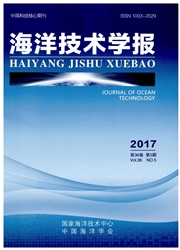

 中文摘要:
中文摘要:
目前,国内外深海走航式XCTD剖面仪信道探测深度在2 000 m范围内,采用阻抗时变金属有线信道的传输方式严重影响了信号的传输质量,成为XCTD大深度测量的难点问题。首先阐述了信号传输DPSK相位解调方法,其次分析了2 000 m测量范围内信号传输的相频特性,进而重点讨论了时变电感、电容量、传输频率对传输信号相位的影响,提出在大深度测量中,时变电感量是影响相位变化的最主要原因,引起相位变化率超过40%,甚至产生振荡,最终提出通过串联固定电感量的方法,使整个测量范围内相位的变化率控制在5.9%,大大提高了DPSK信号解调的准确性,提高了XCTD剖面仪传输信号传输的稳定性。该文的研究结果为深海走航式XCTD剖面仪在大深度测量中提高信号传输质量提供了解决问题的办法,也值得深海走航式XBT、XCP等同类产品参考借鉴。
 英文摘要:
英文摘要:
At present, the channel probing depth of deep-sea vessel-mounted XCTD profilers across the world is in the range of 2 000 m. Using impedance-varying metal wire as transmission channel seriously affects the signal transmission quality and has become a difficult point in XCTD depth measurement. This paper firstly expounds the DPSK phase demodulation method of signal transmission, followed by the analysis of the phase-frequency characteristics of signal transmission in a measuring range of 2 000 m. Then through discussing the influence of time-varying inductance, capacitance and transmission frequency on signal phase, it is concluded that in great depth measurement, time-varying inductance is the main reason to affect the change of phase, resulting in over40% of the phase change, or even leading to oscillating. Finally, this paper puts forward a method of series fixed inductance to control the change rate of phase within 5.9 % in the whole measurement process, enhancing the stability of signal transmission of XCTD profilers. The results of this study provide a solution to improve the quality of signal transmission in the depth measurement of XCTD, as well as a reference for the development of deep-sea vessel-mounted XBT, XCP and other similar products.
 同期刊论文项目
同期刊论文项目
 同项目期刊论文
同项目期刊论文
 期刊信息
期刊信息
